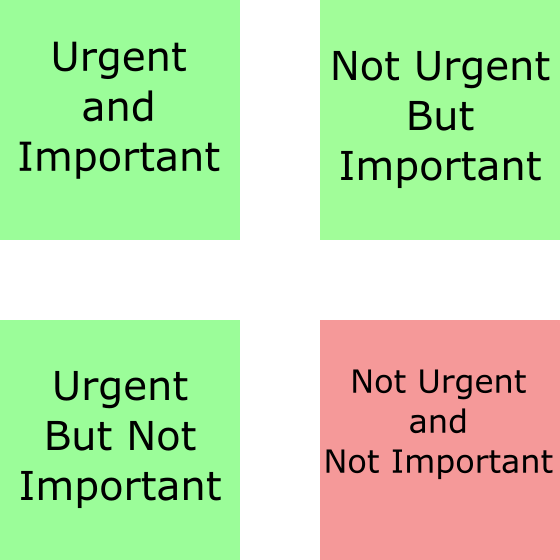5 powerful techniques to improve your productivity
Do you find yourself overwhelmed with tasks, decisions and time management issues that leave you drained and with dread? Or do you download the latest productivity apps hoping it will sort out your responsibilities and make your life easier? I know I have.
The reality is everyone is different. Everyone needs to define a productivity system that meets individual needs.
Over the last twenty years since graduating, I have tried different productivity techniques to help me while working in corporate companies, small companies and managing my own life. I have always come back to the same five techniques that I have incorporated into my productivity system.
In this blog, I will list out the techniquesI use, and how I have implemented them.
Personal Kanban
Kanban is a task management system that lets me visualise my workflow and how I am progressing in that workflow.
The Kanban has three boards.
- 'To-do' board lists out all the incomplete tasks.
- 'Doing' board lists out the tasks that I am completing.
- 'Done' board lists out all completed tasks.

I currently use Trello to manage my Kanban board. I use kanban technique where I have a project with a set of tasks.
An example of this might be setting up this blog. I captured all the tasks related to setting up a blog and placed them in the To-Do board.
Every day when I had time, I would select a task to do and move it to the Doing part of the board.
When I complete the task, I move it to the done board. I try and commit to 1-3 tasks a day. Therefore I know if there are 21 tasks in the To-Do board I would finish in 7 days.
I have completed many projects this way. I think it has been successful because:
- I review the task every day and commit to achieving them. Reviewing helps me to keep on top of things.
- I focus one task at a time. If I try and do too many, I end up overloaded and less likely to complete the project.
- I can see the progress that I am making. This visualisation of progress acts as a driver to do more and see the project through.
One minute To-Do list
One minute To-Do list is a list I create in the morning to ensure that the tasks that I set for the day are urgent and important.

I use this technique to ensure I don't forget tasks that have a deadline and focus on the ones I need to.
I go through each task and tag as follows:
- Urgent. These are tasks that I have a deadline date to deliver.
- Important. These are tasks aligned to goals that I want to achieve.
- Review Later: These are tasks I need to review later on. These could be less important but may become a crucial task one day.
By doing this, I am applying the 80/20 principle. The principle states that 20 per cent of inputs are responsible for 80 per cent of outcomes, by focusing on the top 20% tasks, it gives me the most impact on my goals.
Currently, I am using the Apple iOS reminders app on the Apple ecosystem to track all my daily tasks and prioritise them. But there are many other apps you can use.
There is a great youtube video explaining how to pick one from the Keep Productive channel. (https://www.youtube.com/watch?v=gEqsuuNHqHc)
Eisenhower matrix
I spoke about the tasks that are urgent and important. I use the Eisenhower matrix to determine which task fits which category.
Eisenhower matrix has four parts.

- The first quadrant covers tasks that are urgent and important. An example of this might be paying a tax bill on time.
- The second quadrant includes tasks that are not urgent but important. Example of this is planning goals for the future.
- The third quadrant is for tasks that are urgent but not important. These could be helping someone with a chore.
- The fourth quadrant covers non-urgent and non-important tasks. For me, this would be watching Netflix alone or playing video games.
The Art of Manliness website has some great examples of each of the quadrants.
Pomodoro technique
Once I have a list of tasks, I use the Pomodoro method to work through the tasks.

The basic concept of Pomodoro is to split your time to 25-minute slots for working on tasks than a 5-minute break. Repeat for another 25-minute with another 5-minute break. After four 25-minute slots, you can have a 15 to 30-minute break.
For me, I have adopted a 50-minute window rather than a 25-minute slot as it reflects better my concentration time.
I also do the following:
- Listen to classical piano music via the headphones
- Turn off all communications including email
- Turn off all notifications on the phone
By using this method, I can focus on the tasks that I have to deliver, see how I am progressing and avoid disruption.
Getting things done
Getting Things Done is a methodology for managing tasks introduced by David Allen. It was the primary methodology I adopted when working in a corporate environment. It is easy to understand but implemented in many different ways. That is why I will not cover it here in this blog.

Instead, I want to focus on three concepts that I learned from Dave Allens GTD book.
- Write all your tasks down into an inbox - GTD recommends to capture all the tasks in one place, and this place should not be our brain. It turns out we forget things, and we should write tasks down to process them better.
- Batch similar tasks together - When you have a group of related tasks, e.g. making phone calls. It is best to group them, so you don't have to switch between different activities to complete the tasks
- Put tasks into your calendar - when you have a task, schedule it into your day and add it to your calendar. By adding to your calendar, it helps you estimate the time it takes and prevents people from booking meetings.
Summary
Use Kanban to plan your projects and list tasks.
Create a daily one-minute to-do list to list out the tasks you need to do that day
Use the Eisenhower matrix to prioritise your to-do list, so it covers urgent and essential tasks to achieve your goals successfully.
Use the Pomodoro technique to work through tasks and keep focused.
When you get a new task, record it in one place for review later.
Finally, batch similar tasks together to reduce the effort to change activities and store your tasks in your calendar to avoid people putting in meetings and disrupting your day.